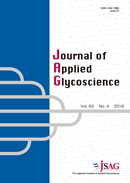
- Issue 4 Pages 87-
- Issue 3 Pages 51-
- Issue 2 Pages 31-
- Issue 1 Pages 1-
- |<
- <
- 1
- >
- >|
-
Takatoshi Koyakumaru, Hirofumi Nakano2016Volume 63Issue 4 Pages 87-98
Published: 2016
Released on J-STAGE: November 22, 2016
Advance online publication: September 09, 2016JOURNAL FREE ACCESS FULL-TEXT HTMLThe effects of sodium hydroxide and urea on the gelatinization of corn starch suspensions, a main component of corrugating starch adhesives, were studied using differential scanning calorimetry (DSC). Sodium hydroxide and urea decreased the gelatinization starting temperature (Ts1), peak temperature, conclusion temperature, enthalpy of gelatinization (DSCΔH), apparent activation energy (ApEa), and van’t Hoff enthalpy change (ΔHvHº). DSC analysis showed the gelatinization endotherm, the melting endotherm of starch−lipid complexes, and an exotherm attributable to the alkali-decomposition of starch. This exotherm was only observed in the first scan for sodium hydroxide additions of more than 3.8 mol%. The existence of the starch−lipid complexes was also suggested by the reappearance of the corresponding endotherm in the second DSC scan. The increases in the gelatinization rate constants caused by the two additives were deduced from the Arrhenius equation using ApEa. The relationship between the temperature corresponding to the half gelatinization transition (Tm) and DSCΔH, and that between Tm and ApEa quantitatively agreed for the two additives, suggesting that gelatinization might be stimulated by a similar mechanism involving breaking intermolecular hydrogen bonds in starch. Only sodium hydroxide caused a significant decrease of Ts1 and broadening of the gelatinization peak. Therefore, ΔHvHº and the size of the gelatinizing cooperative unit estimated from the ΔHvHº/DSCΔH ratio were decreased more by sodium hydroxide than by urea, indicating that sodium hydroxide facilitated the mobility of starch molecules more effectively during gelatinization.
View full abstractDownload PDF (1299K) Full view HTML -
Takashi Kobayashi, Pramote Khuwijitjaru, Shuji Adachi2016Volume 63Issue 4 Pages 99-104
Published: 2016
Released on J-STAGE: November 22, 2016
Advance online publication: October 14, 2016JOURNAL FREE ACCESS FULL-TEXT HTMLThe kinetics of the decomposition and isomerization of glucose and fructose in pure water and water containing sodium chloride (1–20 % w/w) under subcritical conditions at 180–220 °C was investigated. The addition of sodium chloride in subcritical water accelerated the decrease of glucose, and the rate was expressed by the Weibull equation. Although the isomerization of glucose to fructose was observed in parallel with decomposition, the yield of fructose was lower at higher sodium chloride concentrations. Mannose was also formed from glucose with very low yield. It was seen that fructose decomposed much faster than glucose, in pure and salty subcritical water. The decomposition of fructose obeyed first-order kinetics in the initial stages of the reaction and could be expressed by the autocatalytic model in the later stages. The formation of glucose and mannose from fructose was not observed under any of the conditions investigated.
View full abstractDownload PDF (578K) Full view HTML
- |<
- <
- 1
- >
- >|